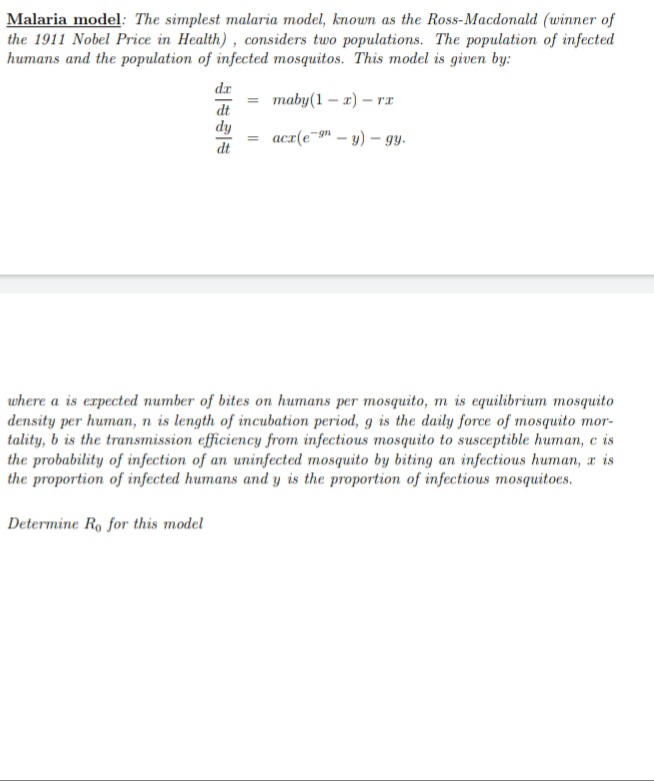Malaria model: The simplest malaria model, known as the Ross-Macdonald (winner of the 1911 Nobel Price in Health), considers two populations. The population of infected humans and the population of infected mosquitos. This model is given by: dr maby(1 – 1) – rI dt dy dt acr(e¯9" – y) – gy. where a is erpected number of bites on humans per mosquito, m is equilibrium mosquito density per human, n is length of incubation period, g is the daily force of mosquito mor- tality, b is the transmission efficiency from infectious mosquito to susceptible human, c is the probability of infection of an uninfected mosquito by biting an infectious human, x is the proportion of infected humans and y is the proportion of infectious mosquitoes. Determine Ro for this model
Malaria model: The simplest malaria model, known as the Ross-Macdonald (winner of the 1911 Nobel Price in Health), considers two populations. The population of infected humans and the population of infected mosquitos. This model is given by: dr maby(1 – 1) – rI dt dy dt acr(e¯9" – y) – gy. where a is erpected number of bites on humans per mosquito, m is equilibrium mosquito density per human, n is length of incubation period, g is the daily force of mosquito mor- tality, b is the transmission efficiency from infectious mosquito to susceptible human, c is the probability of infection of an uninfected mosquito by biting an infectious human, x is the proportion of infected humans and y is the proportion of infectious mosquitoes. Determine Ro for this model
Biology Today and Tomorrow without Physiology (MindTap Course List)
5th Edition
ISBN:9781305117396
Author:Cecie Starr, Christine Evers, Lisa Starr
Publisher:Cecie Starr, Christine Evers, Lisa Starr
Chapter15: Animal Evolution
Section: Chapter Questions
Problem 1CT
Related questions
Question

Transcribed Image Text:Malaria model: The simplest malaria model, known as the Ross-Macdonald (winner of
the 1911 Nobel Price in Health), considers two populations. The population of infected
humans and the population of infected mosquitos. This model is given by:
d.r
тaby(1 - г) —гт
dt
dy
acr(e™" – y) – gy.
dt
where a is erpected number of bites on humans per mosquito, m is equilibrium mosquito
density per human, n is length of incubation period, g is the daily force of mosquito mor-
tality, b is the transmission efficiency from infectious mosquito to susceptible human, c is
the probability of infection of an uninfected mosquito by biting an infectious human, x is
the proportion of infected humans and y is the proportion of infectious mosquitoes.
Determine Ro for this model
Expert Solution
This question has been solved!
Explore an expertly crafted, step-by-step solution for a thorough understanding of key concepts.
Step by step
Solved in 2 steps

Knowledge Booster
Learn more about
Need a deep-dive on the concept behind this application? Look no further. Learn more about this topic, biology and related others by exploring similar questions and additional content below.Recommended textbooks for you

Biology Today and Tomorrow without Physiology (Mi…
Biology
ISBN:
9781305117396
Author:
Cecie Starr, Christine Evers, Lisa Starr
Publisher:
Cengage Learning

Biology: The Dynamic Science (MindTap Course List)
Biology
ISBN:
9781305389892
Author:
Peter J. Russell, Paul E. Hertz, Beverly McMillan
Publisher:
Cengage Learning

Biology: The Unity and Diversity of Life (MindTap…
Biology
ISBN:
9781305073951
Author:
Cecie Starr, Ralph Taggart, Christine Evers, Lisa Starr
Publisher:
Cengage Learning

Biology Today and Tomorrow without Physiology (Mi…
Biology
ISBN:
9781305117396
Author:
Cecie Starr, Christine Evers, Lisa Starr
Publisher:
Cengage Learning

Biology: The Dynamic Science (MindTap Course List)
Biology
ISBN:
9781305389892
Author:
Peter J. Russell, Paul E. Hertz, Beverly McMillan
Publisher:
Cengage Learning

Biology: The Unity and Diversity of Life (MindTap…
Biology
ISBN:
9781305073951
Author:
Cecie Starr, Ralph Taggart, Christine Evers, Lisa Starr
Publisher:
Cengage Learning

Biology 2e
Biology
ISBN:
9781947172517
Author:
Matthew Douglas, Jung Choi, Mary Ann Clark
Publisher:
OpenStax